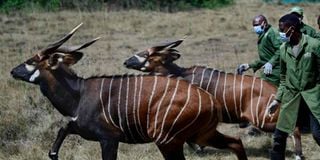A new beginning for rare antelopes on the verge of extinction

What you need to know:
- Hunters in the mountain have been killing the animal, which weighs upto 405 kilos, for food and its horns, which are used to make trophies.
- Between 1969 and 1976, 20 Mountain Bongos were transferred to the United States to be kept in zoos by individuals who wanted to domesticate them.
It’s survival for the fittest for two Mountain Bongo antelopes, which are part of five being reintroduced into the wild at the Mawingu Sanctuary in Laikipia.
The Kenya Wildlife Service (KWS) officers and animal caregivers have to be careful in restraining the herbivores of the genus Tragelaphus eurycerus isaaci, which are currently sedated and require resuscitation to make the journey started in 2004 in Mount Kenya a success.
With seven to six officers on each antelope, the caretakers embark on an onerous duty to rescue the animals from extinction. In case the resuscitation fails, future generations will not know the beautiful coppery-striped animals ever existed.
But in a jiffy, the first Bongo rises and charges towards the bush. A minute later, the officers on the second antelope who have been tightly holding it release it to avoid injuries from its long, sharp and slightly spiralled horns.
It rises and staggers for some seconds before it finds one of the paths in the newly opened 776 acre Mawingu Mountain Bongo Sanctuary.
The release of the five, which happened on March 9, was a milestone in reversing extinction of the species, which the International Union for Conservation of Nature declared to be greatly endangered.
Mountain Bongo bulls live in solitude but females and calves form small herds of up to 10. They are mostly grazers, feeding on leaves, vines, bark and grass but they regularly visit mineral salt licks.
Legend has it that these antelopes were numerous in the wild during the 1970s but their numbers have declined rapidly over the five-decade period.
The cause of the decline? Harsh climatic conditions and human activities. Hunters in the mountain have been killing the animal, which weighs upto 405 kilos, for food and its horns, which are used to make trophies.
Between 1969 and 1976, 20 Mountain Bongos were transferred to the United States to be kept in zoos by individuals who wanted to domesticate them.
With the transatlantic transfers of the nocturnal animals, other generations of the beautiful animal were born; increasing the numbers in the US to 300.
Whereas the numbers in the US increased, back at home, the numbers in the wild reduced at an alarming rate.
Realising that the numbers would reduce to a point where no more bongos would be found in Kenya, the government together with nature conservationists began a programme to repopulate the bongos.
In that front, 18 Mountain Bongos from the 300 in the US were imported into the country in 2004 with the intentions of reintroducing them back into the wild when their numbers increase. Those in the US are still under domestication, and globally, Kenya remains the only country with Bongos in the wild.
Last year, when their number grew to 63, the Mount Kenya Wildlife Conservancy opened a 776-acre sanctuary that is now being used to reintroduce more bongos into the wild.
Mr Robert Aruho, who heads the conservancy, justified the releasing of the bongos into the forest as “their behaviour suggested they no longer wanted to be restricted.”
“For example, some of them have been refusing to eat their feed and choose to fend for themselves in the thickets,” he told Healthy Nation.
They would even go into hiding enclosures and deliver without the KWS vets’ help.
“We would just wake up to a healthy calf. A sign that their wild instincts were now dominant, hence the exercise today,” Mr Aruho said.
While marking the milestone, Tourism and Wildlife Cabinet Secretary Najib Balala congratulated KWS and the conservancy for leading the cause.
According to the CS, nature must be protected as it is the custodian of any nation’s natural resources.
“Conserving the Mountain Bongos is crucial. The journey of reintroducing them into the wild has began and we hope that we shall get to our target of 750 bongos by 2050,” Mr Balala said.
The government turned attention to the bongos after numbers of other endangered species such as lions and elephants stabilised.
The patron for the Mount Kenya conservancy and animal orphanage Humphrey Kariuki said over Sh100 million has been pumped into the protection of the antelopes.
“After all the property we possess is gone, nature is the only thing we remain with. We spend over Sh60 million every year to keep the programme running because of the belief we have in nature,” he said.
Loise Waithaka, a dancer with Kinyoni traditional dancers, said the conservation has given them a source of livelihood in their old age.
“When tourists come to see bongos in the conservancy, we get chances to dance and make some money out of it,” she said.
The conservancy also plays a huge role in controlling human wildlife conflict as it acts as a buffer to shield locals in the Mount Kenya ecosystem against losses caused by wild animals.
According to CS Balala, the government has already approved the importation of more Mountain Bongos from the US to save them from extinction.
Another project that also aims to protect the antelopes is the Bongo Surveillance Project, established in 2004 in the Aberdare forests, which has formed teams of trackers to collect vital data to verify remnant Bongo populations in the wild.
Local trackers identify the areas most used by the bongos, while camera traps provide images of the animals and human activities.
The project also works with local communities and 13 Bongo Wildlife Clubs have been set up in nearby schools known as Bongo locations, reaching over 1,000 people, according to Tusk Trust, a UK-based wildlife conservation financier.





